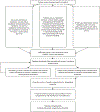Global assessment of national mandatory vaccination policies and consequences of non-compliance
- PMID: 33164808
- PMCID: PMC8562319
- DOI: 10.1016/j.vaccine.2020.09.063
Global assessment of national mandatory vaccination policies and consequences of non-compliance
Abstract
Background: Declining vaccination coverage and increasing hesitancy is a worldwide concern. Many countries have implemented mandatory vaccination policies to promote vaccination. However, mandatory vaccination policies differ significantly by country. Beyond case studies, no comprehensive study has compared these policies or the penalties for non-compliance on a global scale.
Methods: We conducted extensive keyword, policy, and literature searches to identify mandatory national vaccination policies globally and develop a comprehensive database. A mandatory national vaccination policy was defined as a policy from a national authority that requires individuals to receive at least one vaccination based on age or to access a service. Two reviewers independently evaluated evidence for a mandate and whether non-compliance penalties were incorporated. We categorized penalties into four types, based on the nature of the penalty. These penalties impact an individual's financial, parental rights, educational (i.e., child's school entry and access), and liberty status. We rated the severity within each category.
Results: Of 193 countries investigated, 54% (n = 105) had evidence of a nationwide mandate as of December 2018. The frequency, types, and severity of penalties varied widely across all regions. We found that 59% (n = 62) of countries with national mandates defined at least one penalty for non-compliance with a vaccine mandate. Among those, educational penalties (i.e., limiting a child's entry or ongoing access to school) were the most common (69%; n = 43), with most countries with educational penalties refusing school enrollment until vaccination requirements are met (81%; n = 35).
Conclusion: We undertook a comprehensive assessment of national mandatory vaccination policies and identified a diversity of penalties in place to promote compliance. Our results highlight the need to critically evaluate the implementation of non-compliance penalties in order to determine their effectiveness and to define best practices for sustaining high vaccination uptake worldwide.
Keywords: Compliance; Mandatory; Penalties; Policy; Vaccination; Vaccine hesitancy; Vaccines.
Copyright © 2020 The Authors. Published by Elsevier Ltd.. All rights reserved.
Conflict of interest statement
Declaration of Competing Interest The authors declare the following financial interests/personal relationships which may be considered as potential competing interests: All authors have completed the ICMJE uniform disclosure form at www.icmje.org/coi_disclosure.pdf and have no conflicts of interest to declare. NEB has received research grants from the US National Institute of Allergy and Infectious Diseases of the US National Institutes of Health; KG had financial support from the Grand Challenges Undergraduate Research Opportunity Program (UROP) of the University of Minnesota; there are no other relationships or activities that could appear to have influenced the submitted work.
Figures





References
-
- Vanderslott S. OurWorldInData.org; 2018. Available from: https://ourworldindata.org/vaccine-preventable-diseases [accessed 18th November 2019].
-
- Roush SW, Murphy TV. Vaccine-preventable disease table working G. historical comparisons of morbidity and mortality for vaccine-preventable diseases in the United States. JAMA 2007;298:2155–63. - PubMed
-
- Pezzotti P, Bellino S, Prestinaci F, et al. The impact of immunization programs on 10 vaccine preventable diseases in Italy: 1900–2015. Vaccine 2018;36:1435–43. - PubMed
-
- Global Vaccine Action Plan: 2011–2020. World Health Organization; 2012. Available from: https://www.who.int/immunization/global_vaccine_action_plan/GVAP_doc_201... [accessed 18th November 2019].
Publication types
MeSH terms
Substances
Grants and funding
LinkOut - more resources
Full Text Sources
Medical
Miscellaneous

